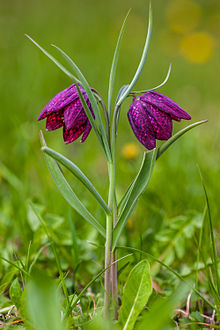
Lilium is a genus of herbaceous flowering plants growing from bulbs, all with large prominent flowers. They are the true lilies. Lilies are a group of flowering plants which are important in culture and literature in much of the world. Most species are native to the northern hemisphere and their range is temperate climates and extends into the subtropics. Many other plants have "lily" in their common names, but do not belong to the same genus and are therefore not true lilies.

Iris is a flowering plant genus of 310 accepted species with showy flowers. As well as being the scientific name, iris is also widely used as a common name for all Iris species, as well as some belonging to other closely related genera. A common name for some species is flags, while the plants of the subgenus Scorpiris are widely known as junos, particularly in horticulture. It is a popular garden flower.

Fritillaria imperialis, the crown imperial, imperial fritillary or Kaiser's crown, is a species of flowering plant in the lily family Liliaceae, native to a wide stretch from the Anatolian plateau of Turkey, Iraq and Iran to Afghanistan, Pakistan, Northern India and the Himalayan foothills. It is also widely cultivated as an ornamental and reportedly naturalized in Austria, Sicily, and Washington State, USA. The common names and also the epithet "imperialis", literally "of the emperor", refer to the large circle of golden flowers, reminiscent of an emperor's crown.
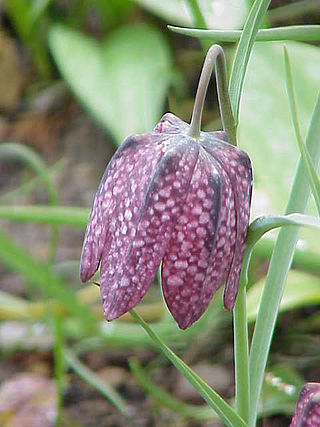
Fritillaria (fritillaries) is a genus of spring flowering herbaceous bulbous perennial plants in the lily family (Liliaceae). The type species, Fritillaria meleagris, was first described in Europe in 1571, while other species from the Middle East and Asia were also introduced to Europe at that time. The genus has about 130–140 species divided among eight subgenera. The flowers are usually solitary, nodding and bell-shaped with bulbs that have fleshy scales, resembling those of lilies. They are known for their large genome size and genetically are very closely related to lilies. They are native to the temperate regions of the Northern hemisphere, from the Mediterranean and North Africa through Eurasia and southwest Asia to western North America. Many are endangered due to enthusiastic picking.

The lily family, Liliaceae, consists of about 15 genera and 610 species of flowering plants within the order Liliales. They are monocotyledonous, perennial, herbaceous, often bulbous geophytes. Plants in this family have evolved with a fair amount of morphological diversity despite genetic similarity. Common characteristics include large flowers with parts arranged in threes: with six colored or patterned petaloid tepals arranged in two whorls, six stamens and a superior ovary. The leaves are linear in shape, with their veins usually arranged parallel to the edges, single and arranged alternating on the stem, or in a rosette at the base. Most species are grown from bulbs, although some have rhizomes. First described in 1789, the lily family became a paraphyletic "catch-all" (wastebasket) group of lilioid monocots that did not fit into other families and included a great number of genera now included in other families and in some cases in other orders. Consequently, many sources and descriptions labelled "Liliaceae" deal with the broader sense of the family.

Leucojum is a small genus of bulbous plants native to Eurasia belonging to the Amaryllis family, subfamily Amaryllidoideae. As currently circumscribed, the genus includes only two known species, most former species having been moved into the genus Acis. Both genera are known as snowflakes.

The scarlet lily beetle, red lily beetle, or lily leaf beetle, is a leaf beetle that eats the leaves, stem, buds, and flowers, of lilies, fritillaries and other members of the family Liliaceae. It lays its eggs most often on Lilium and Fritillaria species. In the absence of Lilium and Fritillaria species, there are fewer eggs laid and the survival rate of eggs and larvae is reduced. It is now a pest in most temperate climates where lilies are cultivated.

Pulsatilla vulgaris, the pasqueflower, is a species of flowering plant belonging to the buttercup family (Ranunculaceae), found locally on calcareous grassland in Europe, and widely cultivated in gardens. It was considered part of the genus Anemone, to which it is closely related. Several sources still list Anemone pulsatilla as the accepted name, with Pulsatilla vulgaris as a synonym.
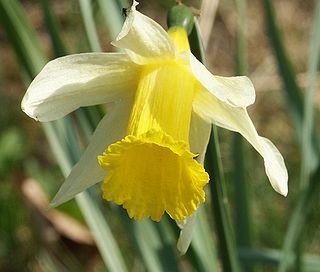
Narcissus pseudonarcissus is a perennial flowering plant.

Framsden is a village and civil parish located around 10 miles (16 km) north of Ipswich and 3 miles (5 km) south of the small market town of Debenham in the English county of Suffolk. The total population of Framsden in the census of 2001 was 299, with 125 households, 52 people under 16 years, 201 of working age and 46 over 65 years, increasing to a population of 357 in 137 households at the 2011 Census.

North Meadow, Cricklade is a hay meadow near the town of Cricklade, in Wiltshire, England. It is 24.6 hectares in size. It is a traditionally managed lowland hay-meadow, or lammas land, and is grazed in common between 12 August and 12 February each year, and cut for hay no earlier than 1 July. This pattern of land use and management has existed for many centuries and has resulted in the species rich grassland flora and fauna present on the site.
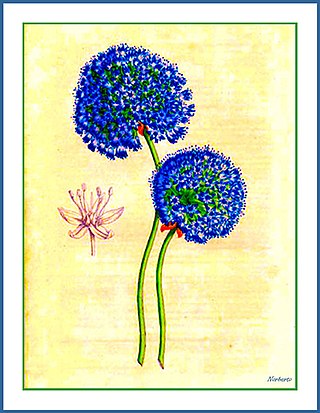
Allium caeruleum is an ornamental bulbous plant of the onion genus, native to Central Asia. In these regions, it is found on dry slopes, plains, and steppes.

Fritillaria camschatcensis is a species of flowering plant native to northeastern Asia and northwestern North America, including northern Oregon, Washington, British Columbia, Alaska, northern Japan, and the Russian Far East. It has many common names, including Kamchatka fritillary and Kamchatka lily.

Fritillaria persica is a Middle Eastern species of flowering plant in the lily family Liliaceae, native to southern Turkey, Iran, Iraq, Lebanon, Syria, Cyprus and Israel. It is widely cultivated as an ornamental and naturalized in the Lazio region of Italy. It is the sole species in Fritillaria subgenus Theresia.
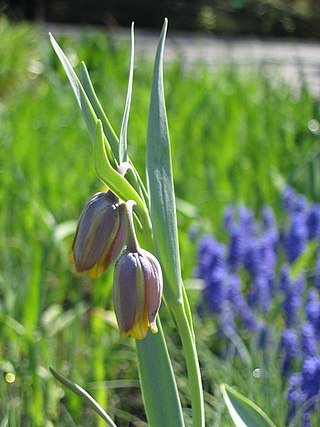
Fritillaria uva-vulpis, commonly called the fox's grape fritillary, is a bulbous perennial plant belonging to the genus Fritillaria and native to eastern Turkey, north-western Iraq and western Iran. They are mainly found in the wooded foothills of the Zagros, where they grow in damp meadows and cornfields between 900 and 1800 m above sea level.
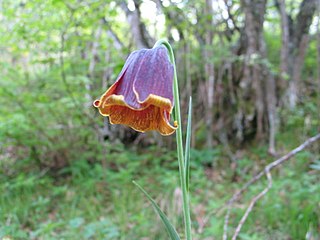
Fritillaria pyrenaica is a species of flowering plant in the lily family Liliaceae, native to the Pyrenees in Spain and France. Common names include Pyrenean fritillary and Pyrenean snake's-head. It is a bulbous perennial growing to 45 cm (18 in). The pendent, bell-shaped flowers are borne in spring. They have recurved tepals which are purple tinged with brown and yellow. Like other species in this genus, notably F. meleagris, they are strongly chequered.

Fritillaria pallidiflora is an Asian species of bulbous flowering plant in the lily family Liliaceae, native to Xinjiang, Kyrgyzstan and Kazakhstan. The common name frequently used is Siberian fritillary, a misnomer because the species does not grow in the wild in Siberia.
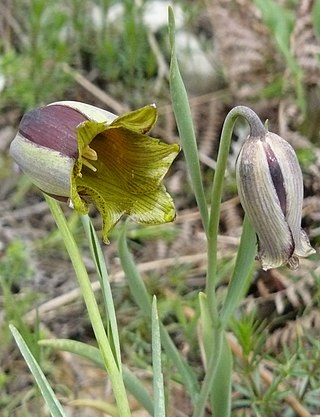
Fritillaria acmopetala, the pointed-petal fritillary, is a species of flowering plant in the lily family Liliaceae, native to rocky limestone mountain slopes in the Middle East. It was described by the Swiss botanist Pierre Edmond Boissier in 1846.

Monewden Meadows is a 3.7-hectare (9.1-acre) biological Site of Special Scientific Interest south-west of Monewden in Suffolk. It is a Nature Conservation Review site, Grade I, and it is managed by the Suffolk Wildlife Trust under the name Martins' Meadows.
Fritillaria cirrhosa, common name yellow Himalayan fritillary, is an Asian species of herbaceous plant in the lily family, native to China, the Indian Subcontinent, and Myanmar.
